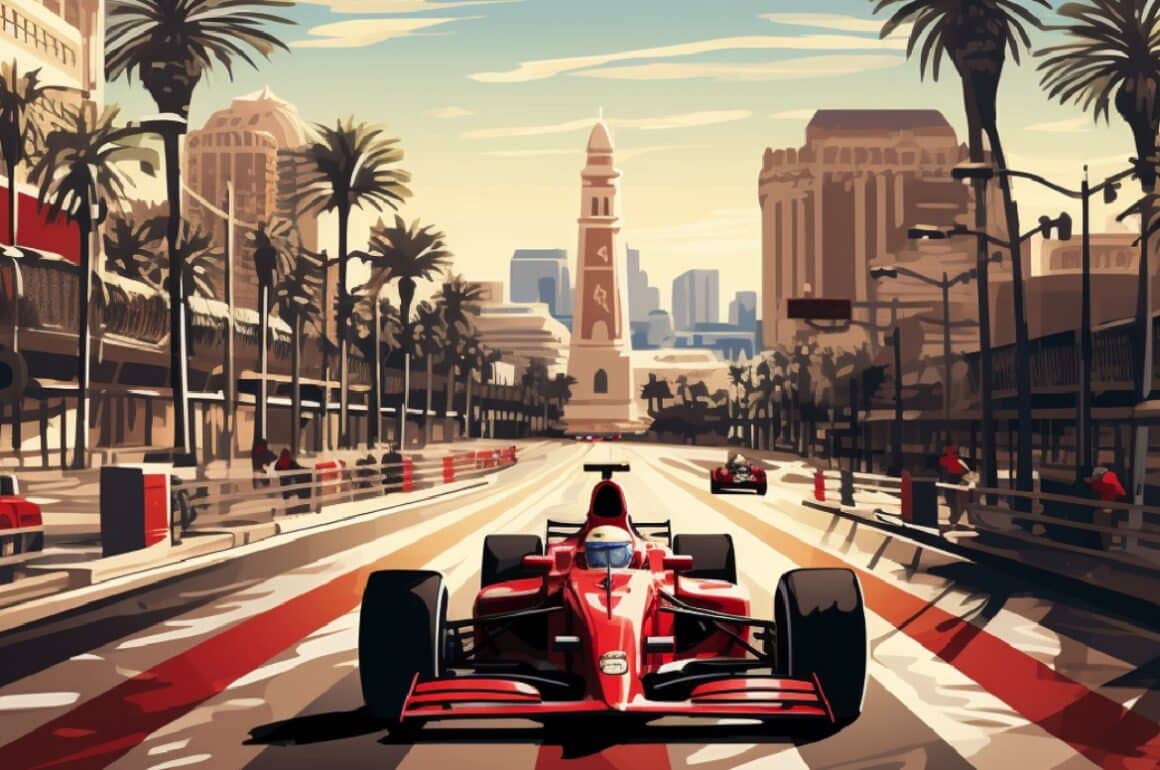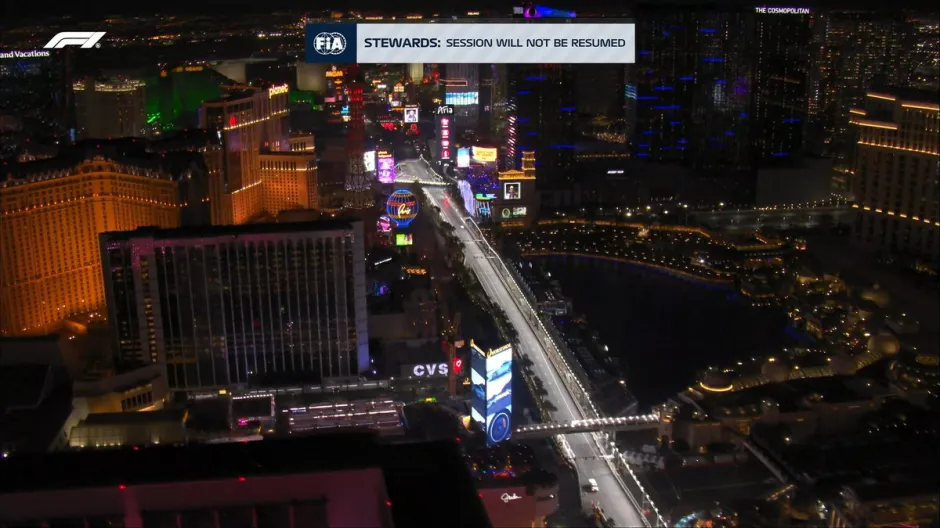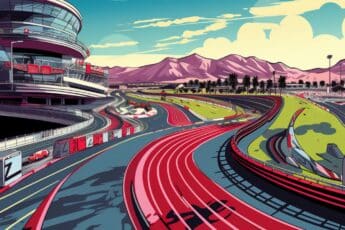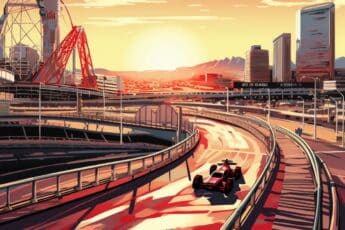
The Las Vegas Grand Prix, a highly anticipated addition to the Formula 1 calendar, kicked off with a mix of excitement and challenges. As the roaring engines and the glitz of the Las Vegas Strip merged, the first in 40 year event promised a spectacle like no other in the history of F1. However, the first day of practice sessions was not without its share of controversies and talking points, painting a complex picture of this high-profile racing weekend.
Practice Session 1: An Unexpected Turn
The opening night, set against the backdrop of the dazzling Las Vegas Strip, was expected to be a smooth showcase of speed and skill. However, the first practice session (FP1) took an unexpected turn, setting the tone for the event’s initial day. The session was abruptly halted following an incident where Carlos Sainz’s Ferrari suffered significant damage due to a loose water valve cover on the track. This unforeseen issue not only raised safety concerns but also led to the cancellation of the remaining FP1 session.
The incident with Sainz was a crucial moment, highlighting the challenges of hosting a race in a non-traditional F1 setting. The Las Vegas Strip, a new entrant in the F1 circuit, presented unique challenges, and the loose water valve cover was a stark reminder of the importance of thorough track preparation and safety measures. The mishap sparked a flurry of activity as race officials and engineers scrambled to inspect and secure the track, ensuring no further hazards.
Mixed Reactions and Safety Concerns
The disruption in FP1 elicited mixed reactions from the teams, drivers, and fans. While some viewed it as an inevitable teething problem for a new race track, others expressed serious concerns over the readiness and safety of the circuit. Ferrari Team Principal Frederic Vasseur’s frustration was palpable as he lamented the damage to their car and the financial implications, calling the situation “unacceptable for F1 today.”
Safety concerns were further echoed by other drivers and team principals. Daniel Ricciardo, the Australian driver known for his candid opinions, expressed alarm over the incident, emphasizing the paramount importance of safety over other considerations. His comments hinted at a broader question: whether the spectacle and commercial aspects of the event were overshadowing fundamental safety checks and preparations.
High Ticket Prices and Fan Experience
The first day of the Las Vegas Grand Prix also brought to light the issue of ticket pricing and fan experience. With general admission tickets reportedly costing over $800, there was a growing sentiment that the event, while spectacular, was becoming inaccessible to many fans. This pricing strategy, seen as unusually high even for a marquee F1 event, stirred debates about the inclusivity and commercialization of the sport.
Moreover, the high ticket prices were not the only concern for fans. As the first practice session was canceled and the second session faced delays, fans who had traveled from far and wide found themselves grappling with confusion and disappointment. The disruption in the schedule, compounded by a lack of clear communication, impacted the overall experience for many attendees, casting a shadow over the otherwise electrifying atmosphere of the event.

Second Practice Session: Late Night Under the Lights
As the clock ticked past midnight, the stage was set for the second practice session (FP2) of the Las Vegas Grand Prix. However, this session too was marred by delays and unexpected turns. Initially scheduled for midnight, the start was pushed back to 2:30 AM due to the ongoing repair works on the track. This delay meant that the session would take place in the unusual early hours of the morning, under the bright neon lights of the Las Vegas Strip, but in front of empty grandstands.
The decision to clear the grandstands was necessitated by the expiration of the security personnel’s shifts. Fans, some of whom had paid premium prices for the experience, were compelled to leave, leading to a surreal scene of a high-profile F1 session conducted without the usual cheering and buzzing crowd. This development added another layer to the ongoing narrative of logistical challenges and fan experience issues that had begun to define the event.
Safety and Logistics: The Predominant Concern
The primary reason behind the delay and the subsequent clearing of the stands was safety. The loose water valve cover incident from FP1 had set off a chain of safety checks and repairs, highlighting the importance of track integrity in F1 racing. The organizers, in their statement, emphasized that no priority was higher than the safety of drivers, fans, and staff. This approach, while necessary, resulted in a significant alteration of the event schedule and fan experience.
The rescheduled FP2 eventually went ahead without further incidents, but the peculiar timing of the session brought to light the complex logistics of hosting an F1 race in a bustling city like Las Vegas. The fact that the track, which traverses a significant part of the Las Vegas Strip, needed to be cleared by 4 AM for commuter traffic, added another dimension to the logistical challenges faced by the organizers.
Teams’ and Drivers’ Adaptability
In the world of F1, adaptability is key, and this was evident during the second practice session. Despite the unusual circumstances and timing, teams and drivers quickly adjusted their strategies and focus. Carlos Sainz, despite the earlier incident and the subsequent car repairs, was back on track, showcasing the resilience and adaptability that F1 teams are known for. However, the shadow of the earlier incident lingered, with Sainz facing a 10-place grid penalty due to the chassis change necessitated by the damage his car suffered in FP1.
Fan Experience and Reactions
The situation for fans, who had expected a seamless and exciting experience, was far from ideal. Many expressed their frustration and disappointment over social media, highlighting the lack of clear communication and the inconvenience caused by the delays and the eventual exclusion from the FP2 session. This sentiment was in stark contrast to the high expectations set by the event’s promoters, who had marketed the Las Vegas Grand Prix as a premium and unique F1 experience.
Looking Ahead: Balancing Spectacle and Substance
As the first day of the Las Vegas Grand Prix came to a close, it left behind a mix of awe and introspection. The spectacle of F1 cars racing through the heart of Las Vegas was undeniably captivating, but the day’s events also raised important questions about the balance between creating a spectacular event and ensuring operational excellence, safety, and fan satisfaction. The lessons from this day would be crucial for not only the remainder of the weekend but also for future races in unconventional venues.
The Las Vegas Grand Prix, with its unique challenges and extraordinary setting, had undoubtedly set the stage for an unforgettable weekend. However, the events of the first day served as a reminder that in the high-stakes world of Formula 1, attention to detail, safety, and fan experience are just as important as the thrill of racing.
Conclusion of the First Day
The first day of the Las Vegas Grand Prix was a testament to the complex nature of hosting a world-class racing event in a new and unconventional location. While the spectacle of F1 cars speeding down the Las Vegas Strip was a sight to behold, the challenges and controversies of the day highlighted the delicate balance between entertainment, safety, and fan engagement. As the teams and organizers looked to the rest of the weekend, the lessons of the first day were clear: meticulous preparation and clear communication are as crucial as the speed and excitement that define Formula 1.


